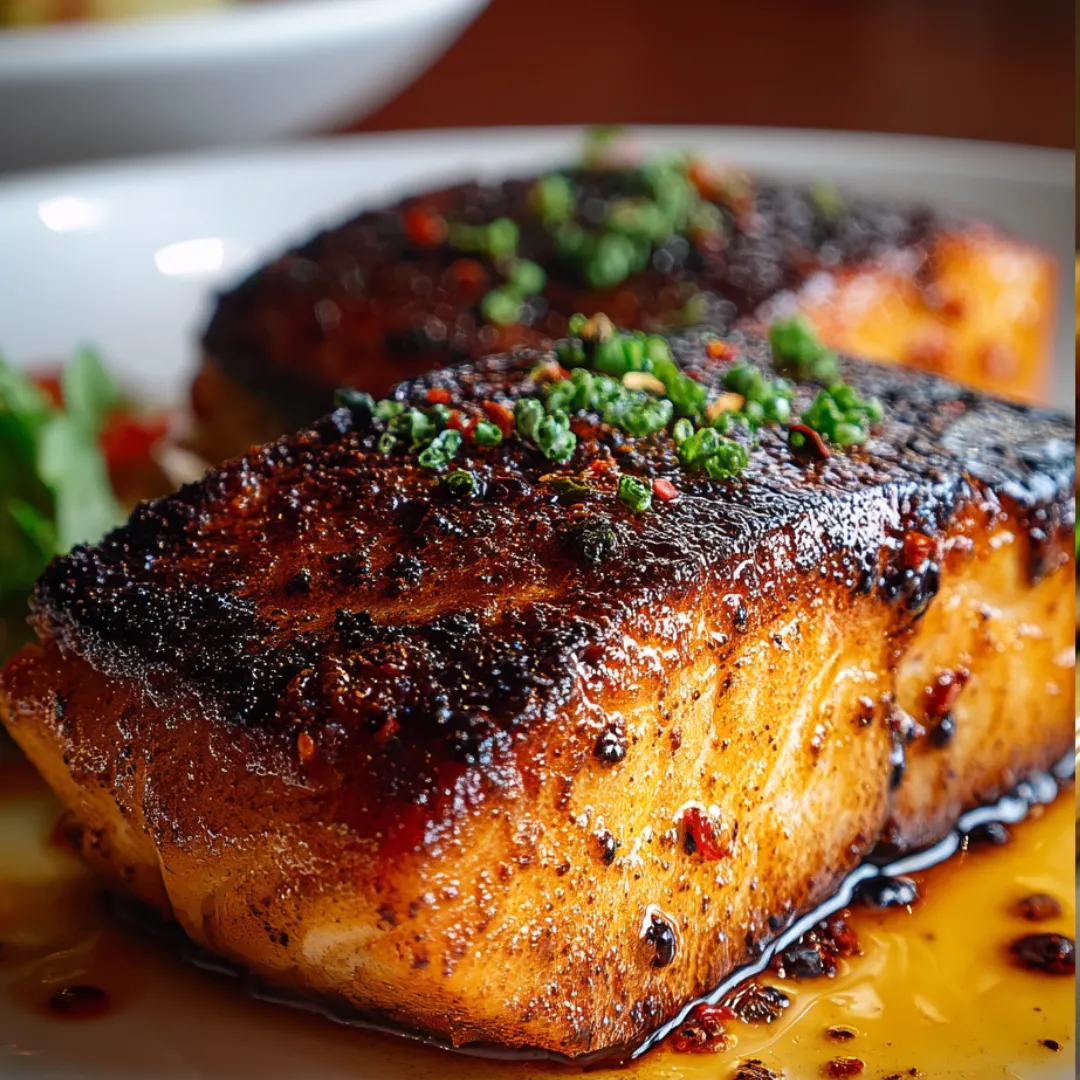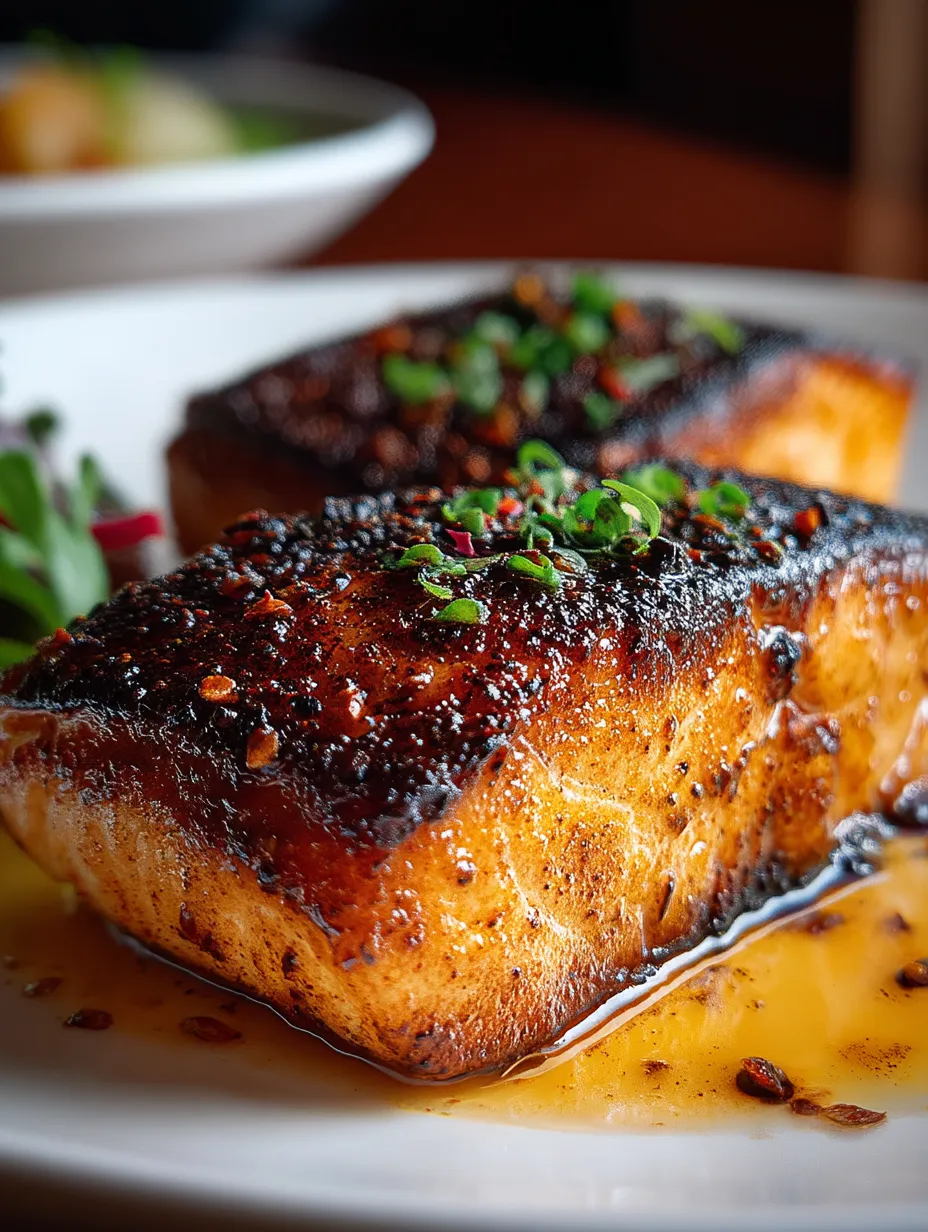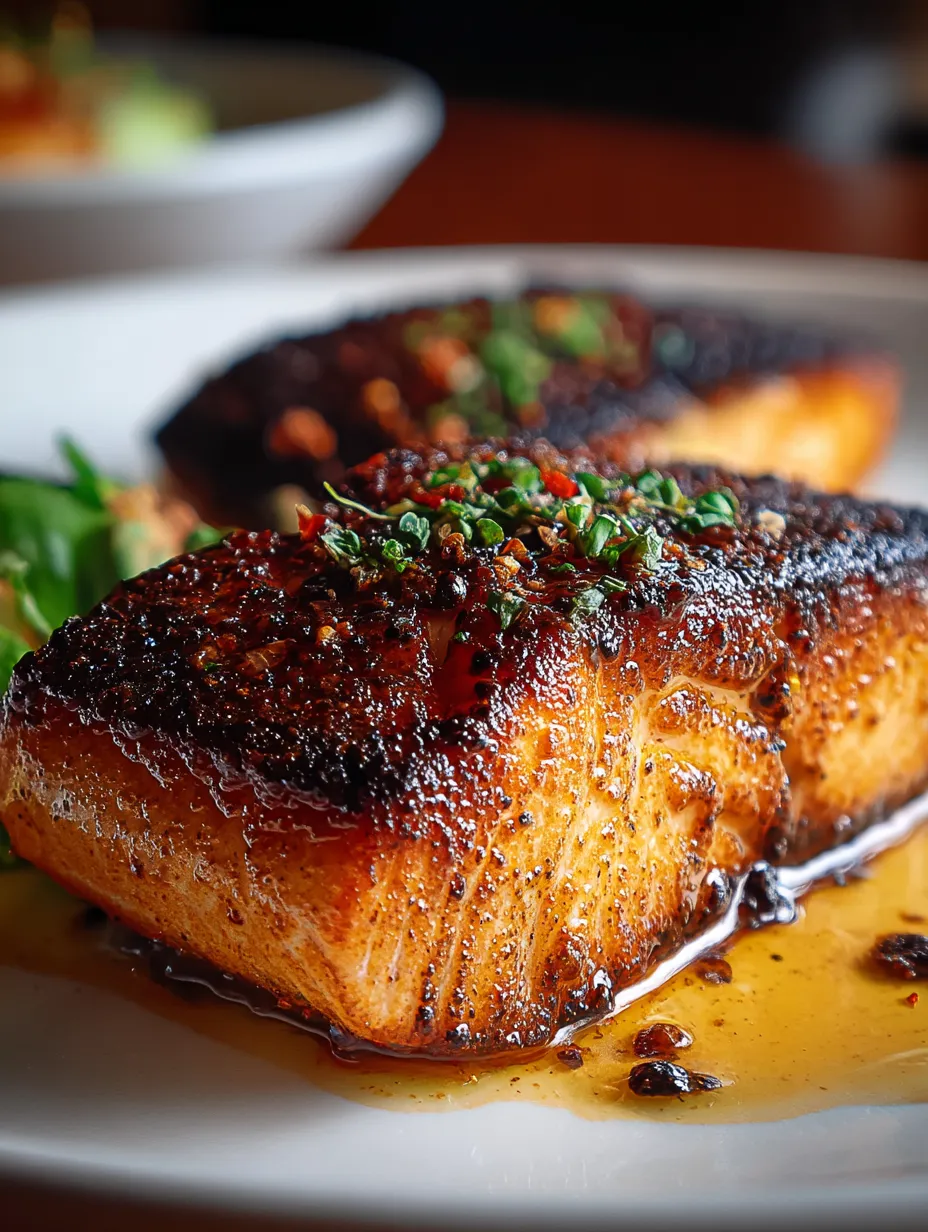 Pin it
Pin it
A perfect crust of smoky, spicy seasoning encases tender flakes of mild, sweet fish in this impressive yet surprisingly simple dish. The high-heat cooking method creates a dramatic contrast between the boldly seasoned exterior and the delicate, moist interior of the fish. Every bite delivers a perfect balance—the initial punch of Cajun spices followed by the clean, slightly sweet flavor of the mahi-mahi. This restaurant-quality meal comes together in under 30 minutes, making it equally suitable for quick weeknight dinners or an elegant centerpiece when entertaining. The vibrant spice blend honors the traditional blackening technique developed in Louisiana while the lean, firm fish provides a perfect canvas for these bold flavors.
I discovered the magic of blackened fish during a trip to New Orleans where I watched, mesmerized, as a chef transformed simple ingredients into something extraordinary in just minutes. After returning home, I attempted to recreate the experience in my own kitchen, expecting disappointment. Instead, even my first imperfect attempt was revelatory—the contrast between the boldly spiced crust and the delicate fish created something far greater than the sum of its parts. My husband, typically indifferent to seafood, now requests this dish regularly, and it's become my go-to when I want to impress dinner guests without spending hours in the kitchen. The dramatic sizzle when the fish hits the hot pan still brings me back to that New Orleans kitchen, and the resulting flavors never fail to transport everyone at my table.
Ingredients You'll Need
- Fresh Mahi Mahi Fillets: The foundation of this dish requires firm, mild-flavored fish that can withstand high-heat cooking. Look for fillets that are firm to the touch with a clean, ocean scent and moist appearance without being slimy. Fresh mahi mahi should have flesh that appears translucent to light pink (never yellow-tinged). Thickness matters—ideally, choose pieces that are an even 1 to 1½ inches thick throughout for consistent cooking. The firm texture of mahi mahi makes it perfect for blackening, as it won't fall apart during the high-heat cooking process. While fresh is preferable, properly thawed frozen fillets work well too—just ensure they're completely defrosted and thoroughly patted dry before seasoning.
- Paprika: Provides the signature vibrant color and smoky foundation of the blackening spice. Look for fresh, bright red paprika with an aromatic scent—old, dull paprika lacks flavor. For added depth, use a combination of sweet and smoked paprika, with the latter adding a rich, mesquite-like quality that suggests hours of slow cooking. Hungarian or Spanish paprika offers more complex flavor than basic varieties. The paprika not only contributes color and flavor but also helps create the characteristic crust when exposed to high heat. Quality matters here, as paprika is the dominant spice by volume in the blend.
- Dried Herbs: Thyme and oregano form the aromatic backbone of authentic blackening seasoning. The herbs should be fragrant when crushed between your fingers—if they smell dusty or have little aroma, it's time to replace them. Mediterranean oregano (Greek or Italian) offers a more complex, authentic flavor than Mexican oregano for this particular dish. These herbs release their essential oils when heated, infusing the crust with earthy, aromatic notes that complement the fish's natural sweetness. When possible, lightly crush dried herbs between your fingers before adding to the spice mix to release more of their essential oils.
- Heat Elements: Cayenne pepper and black pepper provide the characteristic warmth that defines blackened seasoning. The amount can be adjusted based on personal preference—authentic blackening typically has a noticeable kick without overwhelming the palate. Freshly ground black pepper offers significantly more aroma and complexity than pre-ground. The heat from cayenne develops and mellows slightly during the high-heat cooking process, creating a pleasant warmth rather than sharp spiciness. For those sensitive to heat, reducing the cayenne by half still delivers the authentic flavor profile without overwhelming spiciness.
- High-Heat Oil: A high smoke-point oil like avocado, grapeseed, or clarified butter (ghee) is essential for the blackening technique. The oil serves multiple purposes: it helps the seasoning adhere to the fish, facilitates the development of the blackened crust, and prevents sticking to the cooking surface. Traditional blackening often uses clarified butter for its rich flavor, but neutral oils work well for those limiting dairy. The quality of oil matters less than its smoke point—the cooking process requires temperatures that would cause olive oil to smoke excessively and develop bitter flavors.
- Fresh Finishing Elements: Fresh lemon wedges and herbs like cilantro or parsley aren't just garnish but essential components that brighten and balance the finished dish. The acidity of fresh lemon juice cuts through the richness of the spices and complements the fish's natural flavors. Fresh herbs add a pop of color and a final aromatic note that ties everything together. These finishing elements transform the dish from simply well-seasoned fish to a complete culinary experience, providing brightness that balances the bold spice mixture.
 Pin it
Pin it
Step-by-Step Instructions
- Step 1:
- Prepare the blackening seasoning with care – In a small bowl, combine 1 tablespoon of paprika (or a mix of regular and smoked paprika for deeper flavor), 1 teaspoon of onion powder, 1 teaspoon of garlic powder, 1 teaspoon each of dried thyme and oregano (crushing the herbs between your fingers to release their essential oils), ½ to 1 teaspoon of cayenne pepper (depending on your heat preference), ½ teaspoon of ground cumin, and ½ teaspoon each of salt and freshly ground black pepper. Mix thoroughly with a small whisk or fork to ensure even distribution of all spices. This homogeneous mixture is crucial for developing a balanced crust. The combination of herbs and spices should appear reddish-brown with visible flecks of the herbs throughout. This blend can be made in larger batches and stored in an airtight container for up to three months, making future preparations even quicker. The quality and freshness of your spices will significantly impact the final flavor, so use the freshest spices possible.
- Step 2:
- Prepare the fish properly – Remove the mahi mahi fillets from the refrigerator about 15 minutes before cooking to take the chill off, which promotes more even cooking. Using paper towels, thoroughly pat the fillets dry on all sides—this crucial step ensures proper adherence of the spices and promotes better searing rather than steaming. Examine each fillet for any remaining pin bones, removing them with fish tweezers or clean needle-nose pliers if necessary. Check that all fillets are of similar thickness (about 1 to 1½ inches is ideal) to ensure even cooking; if needed, gently press thicker portions to create more uniform pieces. For fillets with skin, you can either leave it on for additional flavor and to help hold the fish together, or remove it with a sharp knife before seasoning, depending on your preference.
- Step 3:
- Season the fish generously – Brush each fillet lightly but thoroughly with high-heat oil (such as grapeseed, avocado, or clarified butter) on all sides. The oil serves two crucial purposes: it helps the seasoning adhere evenly and prevents sticking during the high-heat cooking process. Sprinkle the blackening spice mixture liberally over both sides of each fillet, using approximately 1-2 teaspoons per side depending on the size of the fillet. Press the seasoning gently into the flesh with your fingers to ensure it adheres well. The coating should be generous but not excessively thick—you're aiming for a complete, even coverage that will create a flavorful crust without overwhelming the delicate fish. For the most authentic blackened preparation, the seasoning should completely cover the surface of the fish with no bare spots visible.
- Step 4:
- Prepare your cooking surface properly – Place a cast-iron skillet or heavy-bottomed pan over medium-high heat and allow it to preheat for 3-5 minutes until it's thoroughly hot. A properly heated pan is crucial for the blackening technique—it should be hot enough that a few drops of water flicked onto the surface immediately sizzle and evaporate. Add 1-2 tablespoons of high-heat oil to the skillet, swirling to coat the cooking surface evenly. The oil should shimmer immediately but not smoke excessively. If using a cast-iron skillet, this high heat develops the seasoning of the pan while creating the perfect cooking surface for blackening. Proper ventilation is important during this step, as the high-heat cooking of the spices will create some smoke—turn on your exhaust fan or open windows as needed.
- Step 5:
- Master the blackening technique – Carefully place the seasoned fillets in the hot pan, being sure not to overcrowd—leave at least an inch between pieces and work in batches if necessary. You should hear an immediate sizzle as the fish touches the hot surface; if not, your pan isn't hot enough. Allow the fish to cook undisturbed for 3-4 minutes until a dark (but not burnt) crust forms on the bottom side. Resisting the urge to move the fish during this stage is crucial for proper crust development. Using a fish spatula or tongs, carefully flip each fillet once and cook for an additional 3-4 minutes on the second side, depending on thickness. The blackening technique isn't about burning the spices but rather about creating a deeply colored, flavorful crust through the Maillard reaction—the chemical interaction between amino acids and reducing sugars that creates complex flavors.
- Step 6:
- Cook to perfect doneness – The key to perfectly cooked mahi mahi is knowing exactly when to remove it from the heat. The fish is done when it flakes easily with gentle pressure from a fork but still maintains some translucency in the very center—this slight undercooking at the center accounts for carryover cooking that will continue after the fish is removed from the heat. For precise results, use an instant-read thermometer inserted into the thickest part; the ideal temperature is 137°F (58°C), which will rise to about 140°F (60°C) during resting—fully cooked but still moist. The flesh should appear opaque and pearly white with a hint of translucence at the very center, not dry or overly flaky. If the fillets are of uneven thickness, the thinner portions will cook faster; position these areas toward the outer edges of the pan where the heat is slightly less intense.
- Step 7:
- Rest before serving – Once cooked to perfection, immediately transfer the fillets to a clean plate or serving platter and allow them to rest for 2-3 minutes before serving. This brief resting period is crucial as it allows the fish to complete its carryover cooking and lets the juices redistribute throughout the flesh, resulting in a moister final product. During this resting period, the intense heat from the blackening process will equalize throughout the fish, allowing the flavors to meld and develop. This is also the perfect time to prepare any last-minute accompaniments or to warm your serving plates for an elegant presentation. If you've cooked the fish in batches, you can hold the earlier batches in a warm (200°F/93°C) oven while finishing the remaining fish, but avoid leaving them there for more than 5-7 minutes to prevent overcooking.
- Step 8:
- Finish and serve with complementary accompaniments – Just before serving, squeeze fresh lemon juice over each fillet—this burst of acidity brightens the flavors and cuts through the richness of the spice crust. Garnish with fresh chopped herbs such as parsley, cilantro, or chives for a pop of color and fresh flavor that contrasts beautifully with the bold spices. For an elegant presentation, serve each fillet atop a complementary base such as coconut rice, a bed of wilted greens, or creamy grits. Alternatively, for a more casual presentation, flake the fish and serve in warm tortillas with crunchy slaw and avocado for outstanding fish tacos. Additional lemon wedges should be provided at the table to allow diners to add more brightness to taste. The presentation should highlight the dramatic contrast between the darkened spice crust and the moist, white flesh of the fish within.
I learned the importance of the proper pan temperature through a smoky kitchen disaster during my first attempt at blackening. I'd heated my cast iron pan until it was practically smoking, thinking "the hotter the better." The result was a kitchen filled with eye-watering smoke and fish with a bitter, burnt exterior but raw interior. My husband still teases me about how we had to eat dinner on the patio that night with all the windows open in January. Now I test my pan with a few drops of water – they should dance and sizzle immediately but not violently evaporate. This simple test has transformed my results, creating that perfect restaurant-quality crust without setting off smoke detectors. My eleven-year-old daughter, who normally pushes fish around her plate, now requests "the spicy fish" regularly, carefully scraping every bit of the seasoned crust onto her fork.
Perfect Pairings
This bold, flavorful fish deserves thoughtful accompaniments that complement rather than compete with its distinctive character. For a classic pairing that honors the dish's New Orleans roots, serve alongside creamy cheese grits or dirty rice, which provide a mild, comforting base that balances the spice of the fish.
For a lighter approach, consider a cooling slaw with citrus vinaigrette—the acidity and crunch create perfect textural and flavor contrast with the bold, warm spices of the fish. A simple combination of shredded cabbage, grated carrot, and thinly sliced red onion dressed with lime juice, honey, and a touch of olive oil works beautifully.
Roasted vegetables provide another excellent accompaniment—sweet potato wedges, charred corn, or roasted bell peppers echo the dish's smoky notes while adding complementary sweetness. For a complete meal with visual appeal, serve the fish atop a bed of wilted greens with roasted vegetables arranged around the plate.
For beverages, a crisp, slightly acidic white wine like Sauvignon Blanc or a citrusy wheat beer complements the spice profile perfectly. For non-alcoholic options, sparkling water with lime or a light citrus iced tea provides refreshing contrast.
Beyond Basic Blackening
While the traditional preparation is exceptional on its own, this versatile technique lends itself to numerous creative variations. For a tropical twist, add 1 teaspoon of orange zest to the spice mixture and serve the blackened fish with a fresh mango salsa combining diced mango, red bell pepper, jalapeño, red onion, cilantro, and lime juice.
Create a New Orleans-inspired feast by topping the blackened fish with a spoonful of étouffée sauce or a light crawfish cream sauce. The richness of these sauces complements the bold spice crust beautifully.
For a lighter interpretation perfect for warmer months, serve the blackened fish chilled atop a salad of mixed greens, avocado, grapefruit segments, and a citrus vinaigrette. The contrast between the spiced fish and bright, fresh ingredients creates a perfectly balanced meal.
Transform leftovers into an impressive brunch by flaking the cold fish and folding it into scrambled eggs with a touch of cream cheese and fresh herbs, creating a luxurious breakfast that makes the most of yesterday's dinner.
 Pin it
Pin it
Adapting for Dietary Needs
This versatile dish easily accommodates various dietary preferences while maintaining its signature flavors. For those avoiding dairy, simply use avocado or grapeseed oil instead of butter in both the seasoning and cooking process.
For those limiting spice due to sensitivity or preference, reduce the cayenne pepper by half or omit it entirely, increasing the paprika slightly to maintain the characteristic color. The dish will still offer complex flavor without the heat.
If mahi mahi isn't available, this technique works beautifully with other firm white fish like red snapper, grouper, or halibut. For a more budget-friendly option, farm-raised tilapia or catfish can be substituted, though cooking times may need to be reduced for thinner fillets.
For those following low-carb or keto diets, the dish works perfectly as is—simply pair with non-starchy vegetables or a fresh salad instead of rice or other grain-based sides.
This blackened mahi mahi has become my signature dish, the one friends request when they visit and the recipe most frequently shared from my kitchen. What I love most about it is the dramatic contrast between effort and result—few dishes deliver so much flavor with so little time investment. There's something deeply satisfying about mastering a technique that transforms simple ingredients through nothing more than heat and spice. I've come to believe that the best cooking often lies not in complicated techniques or rare ingredients, but in understanding how to coax maximum flavor from quality ingredients through simple, time-tested methods. This dish exemplifies that philosophy—it's impressive without being pretentious, special without being fussy, and always, reliably delicious.
Frequently Asked Questions
- → What is 'blackened' cooking?
- Blackening is a cooking technique where fish or meat is coated with spices and cooked quickly in a very hot pan, creating a dark, flavorful crust while keeping the inside tender.
- → How do I know when the Mahi Mahi is done?
- The fish is done when it flakes easily with a fork and reaches an internal temperature of 145°F. The outside will have a dark, crispy crust while the inside remains moist.
- → Can I make this recipe less spicy?
- Absolutely! Reduce or omit the cayenne pepper in the seasoning blend for a milder version that still has all the wonderful flavors without the heat.
- → What side dishes go well with blackened Mahi Mahi?
- Try serving with coconut rice, mango salsa, roasted vegetables, or a simple green salad. For a complete Cajun-inspired meal, serve with dirty rice or corn maque choux.
- → Can I use this blackened seasoning on other types of fish?
- Yes! This seasoning works great on other firm white fish like tilapia, cod, or snapper. It's also delicious on salmon, shrimp, chicken, or even tofu for a vegetarian option.
